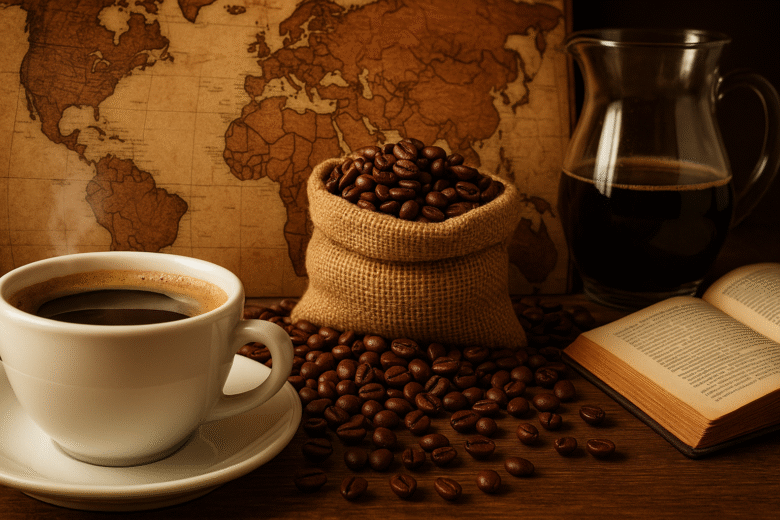Coffee has been part of human life for centuries, but its cultural significance has evolved dramatically over time.
What started as a regional beverage in ancient Ethiopia has grown into a global phenomenon that influences economies, social habits, and even identity.
Each culture has adapted coffee to its own traditions, creating a fascinating journey of taste, ritual, and meaning. The evolution of coffee culture is not just a story about a beverage—it’s a mirror of human development and globalization.
The Origins: From Ethiopia to the Arab World
The legend of Kaldi, the Ethiopian goat herder who discovered coffee after noticing his goats became energetic from eating red berries, marks the mythical beginning of coffee’s journey.
Historical evidence places the first use of coffee in Sufi monasteries in Yemen, where it was used to stay awake during long nights of prayer.
From there, coffee spread across the Arab world. By the 15th century, it was a well-established cultural element in cities like Mecca and Cairo, often consumed in qahveh khaneh, or coffee houses.
These establishments became hubs of intellectual exchange and storytelling. Coffee houses were called “Schools of the Wise,” and they laid the groundwork for the drink’s later role in social and political life.
Coffee in Europe: From Suspicion to Social Status
When coffee entered Europe in the 17th century, it was initially met with skepticism. Some called it the “bitter invention of Satan.” But once Pope Clement VIII blessed it, saying it was “so delicious it would be a sin to let only the infidels enjoy it,” its popularity soared.
Coffee houses quickly spread across England, France, Austria, and Italy. In London, they were nicknamed “penny universities” because for the price of a coffee, one could engage in deep conversation and hear intellectual debates.
In Vienna, coffee culture took on a more refined aesthetic, with the creation of elegant cafés that encouraged leisure, literature, and music.
The Birth of the Café Culture
Parisian cafés in the 18th and 19th centuries played a central role in shaping political and artistic movements. Writers, philosophers, and revolutionaries alike made cafés their base.
Figures such as Voltaire and Rousseau were known to frequent these spots, sipping coffee while discussing the ideas that would shape modern Europe.
In Italy, espresso culture emerged, emphasizing strong, quick coffee and deep social engagement. The barista became a cultural figure in their own right, and the espresso bar became a cornerstone of daily life.
Coffee and the American Experience
In the United States, coffee culture developed differently. It became associated with work, productivity, and convenience.
The American preference for drip coffee and take-away cups mirrored the country’s fast-paced lifestyle. The rise of chains like Starbucks in the late 20th century shifted the focus from caffeine to experience.
Starbucks turned coffee into a lifestyle product. It brought Italian espresso to American streets and emphasized personalization, ambiance, and consistency.
This helped lay the foundation for a new wave of coffee culture that would emphasize quality and origin in the decades to come.
Third-Wave Coffee: A Cultural Renaissance
The third wave of coffee began in the early 2000s as a response to mass-market, commercialized coffee. It emphasized transparency, sustainability, and the artistry of brewing.
Much like wine, coffee began to be appreciated for its terroir, roast profile, and processing methods. Coffee drinkers were encouraged to know where their beans came from, how they were roasted, and how they were brewed.
Small-batch roasters, independent cafés, and manual brewing techniques became more common. The barista became not just a server, but an educator and artisan.
Third-wave coffee culture is about storytelling. Every cup tells a story of its origin, the farmer who grew it, the roaster who refined it, and the barista who crafted it.
Coffee and Identity in the Modern World
Today, coffee is deeply tied to identity. People align themselves with certain coffee styles, brands, and rituals as an extension of who they are.
For some, being a pour-over enthusiast represents a commitment to craft. For others, ordering a customized iced latte from a chain shows a preference for convenience and personalization.
In many urban centers, coffee is part of the rhythm of daily life. It marks transitions: from home to work, from work to rest, from individual time to social engagement.
Coffee shops serve as “third places”—locations that are not home or work, but offer community, Wi-Fi, and a sense of belonging.
The Role of Technology and Innovation
Coffee culture continues to evolve with technology. Apps allow consumers to order ahead, review beans, and learn brewing techniques.
Smart coffee machines now connect to phones, ensuring perfect timing and temperature for each brew.
Social media platforms like Instagram and TikTok have helped turn coffee into a visual experience, with latte art and aesthetic setups driving engagement.
This digital presence has helped local coffee scenes gain global attention, allowing small cafés in distant cities to attract international audiences.
Coffee as a Cultural Bridge
One of the most remarkable aspects of coffee is how it bridges cultures. It is both a global and local experience, shared by people from all walks of life.
A cup of Turkish coffee has meaning that is centuries old, just as a nitro cold brew in a New York café represents modern experimentation.
Coffee connects people. It is offered to guests as a gesture of hospitality, shared during celebrations, and sipped quietly during moments of reflection.
Wherever you are in the world, chances are someone nearby is enjoying a cup of coffee—each for their own reasons, yet part of the same global ritual.
A Symbol of Progress and Sustainability
Today’s coffee culture also comes with a growing awareness of ethical sourcing, fair trade, and environmental impact.
Consumers are more conscious than ever about where their coffee comes from and how it’s produced.
Sustainable farming practices, biodegradable packaging, and equitable treatment of farmers have become central topics in the coffee world.
This cultural shift reflects a broader movement toward more mindful consumption and global responsibility.
Looking Ahead: The Future of Coffee Culture
As we look to the future, coffee will continue to be shaped by innovation, climate change, and cultural values.
We may see lab-grown coffee, new brewing technologies, and evolving rituals as societies continue to change.
But one thing will remain constant: coffee’s power to connect people, inspire conversation, and anchor daily life in something both ordinary and deeply meaningful.
Coffee is no longer just a drink. It’s a global language, a cultural artifact, and a shared human experience that continues to evolve.

Marcio Luzardo is a coffee enthusiast and the voice behind Tudo Viraliza. With a passion for turning curiosity into practical knowledge, he shares easy-to-follow tips, guides, and insights to help readers enjoy better coffee every day. When he’s not writing, Marcio is exploring new brewing methods or diving into the rich stories that connect coffee to culture, lifestyle, and wellness.


